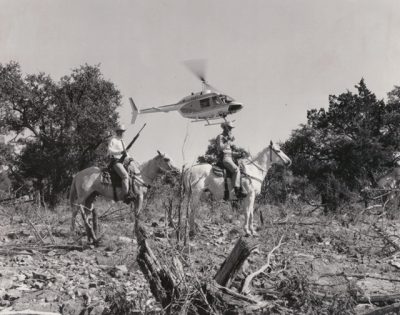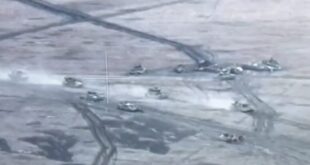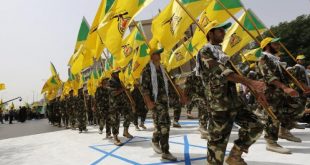
Texas Rangers
The Texas Ranger Division is a major division within the Texas Department of Public Safety with lead criminal investigative responsibility for the following: major incident crime investigations, unsolved crime/serial crime investigations, public corruption and public integrity investigations, officer involved shooting investigations, and border security operations. The Texas Ranger Division is comprised of 234 full time employees; including 166 commissioned Rangers and 68 support personnel; including administrative staff, Border Security Operations Center, Joint Operations and Intelligence Centers, and the Special Weapons and Tactics team.Texas Rangers

Silver Stars and Sixguns:
The Texas Rangers

“They were men who could
not be stampeded”
That’s the way the late Colonel Homer Garrison, Jr., longtime director of the Texas Department of Public Safety, once described the men who have worn the silver or gold star of the Texas Rangers, the oldest law enforcement agency in North America with statewide jurisdiction.


Beginnings Of The DPS
The Texas Senate, on September 25, 1934, formed a committee to investigate crime and law enforcement in the state. The committee produced a report in early 1935 that was singularly critical of Texas law enforcement. However, the document also proposed a solution: the creation of a state law enforcement agency to be known as the Department of Public Safety.
Under the new DPS, the Ranger force would consist of 36 men. Though smaller than it had been in years, the Texas Rangers would have for the first time in its history the benefits of a state-of-the-art crime laboratory, improved communications, and, perhaps most importantly, political stability. In name, the Rangers were 100 years old. With the creation of the DPS, the Rangers would have professionalism to match their tradition.
Tom Hickman, a veteran Ranger, was named Senior Captain of the Rangers. The force was organized into five companies, each headed by a captain.
Within a year of their incorporation into the DPS, the Texas Rangers got national publicity with the opening of the Texas Centennial Exposition at the State Fair grounds in Dallas. The headquarters for Company B was set up in a specially-built log building on the fair grounds. Texas Rangers were seen in newsreel footage in movie houses around the nation.
Modernization
Depression-era DPS appropriations were lean, but as the decade of the 1930s ended, the Texas Rangers were on their way toward modernization. Fingerprint and modus operandi files were available for Ranger use at the Department’s Camp Mabry headquarters in Austin, and Ranger vehicles were equipped with police radio receivers, though two-way radio would not be available to Rangers until the 1940s. Former Ranger Manuel T. (Lone Wolf) Gonzaullas headed the Department’s Bureau of Intelligence, which gave Rangers the benefit of chemical ballistic and microscopic testing in their criminal investigations.
In their early years as part of the DPS, Rangers were furnished a Colt .45 and a lever action Winchester .30 caliber rifle by the state. Rangers had to provide their own car, horse, and saddle, though the DPS issued horse trailers and paid automobile mileage.
For the first time, Rangers had the benefits of in-service training. Weekly activity reports of their activities was required.
Keeping The Peace
Rangers continued to add to their legend during the 1950s. When inmates in the Rusk State Hospital for the Criminally Insane rioted and took hostages, Ranger Captain R. A. “Bob” Crowder walked into the maximum security unit armed only with the .45 on his hip. Crowder and the leader of the mob had a conversation and the inmates surrendered.
Rangers made national headlines by their quiet but firm presence at various campuses in the state as school integration was for the most part peacefully implemented. When violence seemed possible at the high school in Mansfield, Rangers were sent to the school. A photograph of Ranger Sergeant Jay Banks, reflectively leaning against a tree in front of the high school as students walked into the building beneath a dummy hanging in effigy, was widely published.
Also during the 1950s, Rangers calmed down a violent steel mill strike in East Texas; shut down illegal gambling in Galveston and participated in numerous cases, some sensational, many merely routine investigations.
Ranger activity in these cases usually was documented as briefly as possible. This was Ranger Zeno Smith’s report for July 3, 1956: “Wilson County Sheriff requested the assistance of one Ranger in the investigation of twenty-five head of cattle near Floresville. A lengthy investigation resulted in the filing of five complaints and indictments in each case against the suspect who is still at large. 115 hours.”
Specialized Units

In 2018, a total of 2726 investigations resulted in 1071 felony arrests, 77 misdemeanor arrests. The Texas Rangers secured 7660 statements, including 758 confessions to various crimes. There were 524 convictions for various crimes investigated that resulted in 5 death sentences, 62 life sentences and a total of 7041 years in penitentiary time being assessed. Rangers conducted 15 hypnosis sessions on criminal investigations.
Several units and teams in the Ranger Division are charged with handling a variety of specialized functions:
Special Operations Group
The Special Operations Group is comprised of six programs designed to effectively deal with the threats posed by criminal organizations, terrorists (both international and domestic), and the threats posed to the border region by drug trafficking organizations (DTO’s). The Special Operations Group leverages the Department’s assets and resources to resolve critical incidents, through a task force initiative under the incident command structure.

- The Special Weapons and Tactics Team (SWAT) is a highly trained team headquartered in Austin, whose primary mission is responding statewide to critical incidents of a high risk nature; such as hostage situations, barricaded subjects, active shooter incidents and high risk warrant service.
- The Bomb Squad is integrated with and a component of the SWAT Team under the Texas Rangers Special Operations Group. The Bomb Squad provides primary response to crisis situations involving explosive devices, improvised explosive devices, vehicle-borne improvised explosive devices as well as communicated threats involving hazardous devices. Bomb technicians undergo rigorous training courses involving a multitude of hazardous devices including improvised explosive devices, bomb threats, recovered explosives, response protocols and many other counter terrorism related situations at Red Stone Arsenal, Huntsville, Alabama. In the course of dealing with these types of critical incidents, Bomb technicians who are trained in post blast investigations provide subject matter expertise in the investigation of incidents involving explosive devices. The Bomb Squad is accredited by the Federal Bureau of Investigation under Nationally recognized guidelines for Bomb Squads.

- The Ranger Reconnaissance Team is a highly trained tactical team whose primary responsibility is to carry out specific missions, usually along the Texas-Mexico border region or wherever needed. The team is designed to conduct both overt and extended covert operations in remote areas where conventional law enforcement cannot operate. The teams focus is to gather intelligence, conduct interdiction, and disruption of criminal activity usually associated with drug cartels.

- Special Response Teams (SRT) is specialized teams which operate on an “as needed” basis and are located within each of the DPS Regions. SRT is comprised of a cross section of officers from Texas Highway Patrol, Criminal Investigations Division and the Texas Rangers. SRT members are trained to conduct high risk warrant service and provide initial response to critical incidents involving barricaded subjects, hostage situations, and active shooter incidents within their respective DPS regions.
- Crisis Negotiation Teams (CNT) is specialized teams who are trained to facilitate the professional resolution of critical incidents involving emotionally disturbed individuals, hostage situations, and/or barricaded subjects. CNT members are comprised of a cross section of officers from Texas Highway Patrol, Criminal Investigations Division and the Texas Rangers, who respond to incidents within their respective regions. CNT members deploy as a team and are tasked with the evaluation and resolution of the critical incident, collection of necessary intelligence, and relaying incident information to the Special Operations Commander.
- Border Security Operations Center (BSOC) – Joint Operations and Intelligence Centers (JOIC). The Border Security Operations Center (BSOC) is headquartered in Austin and serves as the focal point for the six Joint Operations and Intelligence Centers (JOICs) located along the Texas/Mexico border. Responsibilities include analyzing intelligence and collecting border security information, while collaborating with state, local, and federal law enforcement partners to conduct intelligence-directed border enforcement operations and ensure information exchange between agencies. BSOC is tasked with the timely dissemination of intelligence through a variety of mediums to law enforcement and governmental partners, including the in-depth weekly Border Operations Sector Assessment of the Texas/Mexico border. BSOC operates the State of Texas’ technology initiatives to combat criminal and border exploitation while supporting tactical initiatives, such as the Special Operations Group.
Texas Rangers Specialized Programs
Unsolved Crimes Investigation Program
The mission of the Unsolved Crimes Investigation program is to provide Texas law enforcement agencies with a process of investigating unsolved murders or what appears to be a serial or linked criminal transaction. Since there is no statute of limitations on the offense of murder, the state has the moral and statutory obligation to pursue these cases to a successful resolution or until no other leads are viable.
Public Corruption Unit
The 81st session of the Texas Legislature passed HB2086; this bill created the Public Corruption Unit within the Texas Department of Public Safety, under the responsibility of the Texas Ranger Division. The Texas Rangers are committed to fighting public corruption, as it relates to public officials, law enforcement officers, and others that hold a position of public trust. Fighting corruption is vital to preserving our democracy, protecting our borders, and securing our communities.
Public Integrity Unit
The Texas Ranger’s Public Integrity Unit is responsible for investigating crimes committed by state officers and state employees.
In 2015, the 84th Texas Legislature passed House Bill 1690, which created a Public Integrity Unit within the Texas Ranger Division of the Texas Department of Public Safety to investigate offenses against public administration.
Texas Rangers
The Texas Ranger Division is comprised of 234 full time employees; including 166 commissioned Rangers and 68 support personnel; including administrative staff, Border Security Operations Center, Joint Operations and Intelligence Centers, and the Special Weapons and Tactics team.
The Texas Ranger Division created a Special Operations Group to be tasked with the oversight of the Special Weapons and Tactics team, Regional Special Response Teams (SRT’s), Ranger Reconnaissance Team, Crisis Negotiations Unit, and the Explosive Ordnance Disposal. The Texas Rangers currently coordinate border security operations through six (6) Joint Operations and Intelligence Centers (JOICs) along the Texas-Mexico border and Coastal Bend area of the state. In response to legislation, the Texas Rangers created a Public Corruption Unit and an Unsolved Crimes Investigation Program.
In 2018, a total of 2726 investigations resulted in 1071 felony arrests, 77 misdemeanor arrests. The Texas Rangers secured 7660 statements, including 758 confessions to various crimes. There were 524 convictions for various crimes investigated that resulted in 5 death sentences, 62 life sentences and a total of 7041 years in penitentiary time being assessed. Rangers conducted 15 hypnosis sessions on criminal investigations.Texas Rangers
 Soldier of Fortune Magazine The Journal of Professional Adventurers
Soldier of Fortune Magazine The Journal of Professional Adventurers






